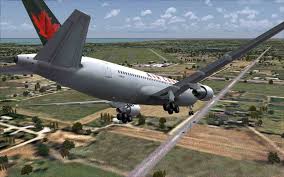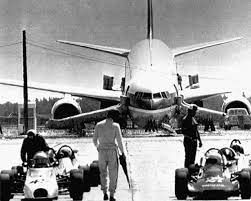
“If you can walk away from a landing, it’s a good landing. If you use the airplane the next day, it’s an outstanding landing.” – Chuck Yeager
* * *
In July 1983, Air Canada Flight 143, a Boeing 767 airliner, took off from Montreal to fly to Edmonton with an intermediate stop in Ottawa. The trip ended somewhat prematurely.
Now, when you get ready to take a road trip, how do you handle the fuel? I’m guessing you go to the gas station and fill your car up, even if it’s a short trip, right? But airlines don’t do that. It’s common practice to load enough fuel into the plane to get it to its destination, and then on for another 45 minutes or so, to take care of any unforeseen circumstances. The reasoning is that filling the fuel tanks all the way adds a lot of weight to the plane, thereby making it more expensive to fly. There are tools to determine the amount of fuel to add to the plane before take-off.
That’s where the problem for Flight 143 began.
The fuel quantity indicator on the Canadian airplane was found to be defective, but there was no replacement available, so the crew manually determined the amount of fuel needed to fly all the way to Edmonton. This involved measuring the amount of fuel with a floatstick and doing some mathematical calculations and conversions. Mistakes were made. The plane took off on its journey and made the intermediate stop in Ottawa. As it departed Ottawa, no one knew that it didn’t have enough fuel onboard to make it to Edmonton.
The Boeing 767 is a two-engine aircraft. Flying toward Edmonton, it was at an altitude of about 41,000 feet when the left engine fuel pressure alarm sounded. The cockpit crew assumed it was a fuel pump problem and silenced the alarm, knowing the system was gravity-fed in flight. A few seconds later, the right engine fuel pressure alarm sounded. The crew decided to divert the flight to Winnipeg, but still had no idea about the real problem they were facing.
As they began their descent, the left engine stopped functioning. The crew began procedures for a single engine landing, but almost immediately, the right engine also failed. Air Canada Flight 143 was now a glider with a crew that had never been trained on a total engine-out emergency. The 767 emergency manual had no information on an unpowered landing.
Giving out of fuel in an aircraft at 35,000 feet is a problem. You can’t just pull over onto the nearest cloud and think things through. You have to land the plane. Whatever it takes, wherever you are, you have to put the plane on the ground, preferably in one piece.
Fortunately, an aircraft that has lost all power will not just fall out of the sky like a rock. Even in a heavy airliner, the wings will provide enough lift for the plane to glide, however clumsily. Fortunately, the pilot of Flight 143 was also an experienced glider pilot, and he calculated what he thought was the best glide speed at 220 knots. That would give the plane a glide ratio of around 12:1, meaning the plane would fly forward about twelve miles for each mile it lost in altitude. Flying at 35,000 feet, they had a radius of around 80 miles to find a place to land.
The pilot instructed the first officer to locate the nearest airport. They decided on the Royal Canadian Air Force base at Gimli. The base was closed, and the runway had been decommissioned, but the runway still existed. What the crew didn’t know was that the runway was used by car enthusiasts for racing, and there was an event in progress.
As the plane approached Gimli, the pilot realized they were coming in too high and too fast. One way to handle that in a normal airplane is to go around the field and approach at a lower altitude, but without power in the aircraft, the pilot didn’t think he had enough altitude to execute a complete turn, so he opted to perform a forward slip to land. This maneuver requires the pilot to cross-control by turning the rudder in one direction while the ailerons are turned the other way. The result is the aircraft continues its forward trajectory, but the nose is pointed at an angle to the side. The air hitting the fuselage will slow the plane and cause it to descend rapidly. The pilot will undo the cross control just before landing so the plane will be back in its correct configuration. It’s a maneuver that’s well-known to pilots of gliders or light aircraft, but is rarely to never performed in a passenger jet.
Fortunately, the people on the ground saw the 132-ton silent behemoth bearing down on them and were able to scramble clear of the runway in time.
Although the crew managed to get the landing gear down, the nose wheel did not lock in place. That turned out to be a bit of luck because, when the plane touched down, the nose wheel collapsed, and the friction helped slow the plane to a halt. It did not run off the end of the runway, and there were no serious injuries.
The aircraft was repaired and put back into service where it flew until its retirement in 2008. That airplane would forever be known as the Gimli Glider.

That was one awesome bit of flying by Captain Bob Pearson and First Officer Maurice Quintal. They deserved a medal for their piloting skill and calm in the face of imminent disaster, and they got one. In 1985, they received the Fédération Aéronautique Internationale Diploma for Outstanding Airmanship.
* * *
There are similarities between flying an airplane and writing a novel. In order to fly an airplane, there are two things you have to do:
#1 – You must take off
#2 – You must land
According to Heinlein’s Business Rules (and I hope Harvey Stanbrough is reading this) there are certain things you must do when writing a novel. The first two are:
#1 – You must write
#2 – You must finish what you write
But whether you’re flying or writing, there can be some turbulence and maybe even a few surprises in between those two steps.
The writing journey will certainly include a months-long effort of plotting, drafting, outlining (or not), editing, revising, and getting feedback. But eventually, the writer has to bring the novel in for a landing.
The checklist for putting it down safely may be long. There are final edits, cover design, formatting, endorsements, copyright, ISBN, Library of Congress, and so on. It may be stressful, but at some point, you just have to let go and land the thing.
Several of us are on final approach or have recently landed our novels. Terry Odell just published Deadly Relations and Debbie Burke’s Deep Fake Double Down is available on pre-order now. My novel Lady Pilot-in-Command is in the hands of the copy editor, and beta readers are sending me feedback. Other TKZ authors have recently touched down or are approaching the runway.
Whatever the status of your work, I wish you a good journey and a happy landing.
* * *
So TKZers: Have you ever run into problems with a novel in mid-flight? How did you solve them in order to land the book? Are you on final approach or have you landed a novel recently? Tell us about it.
